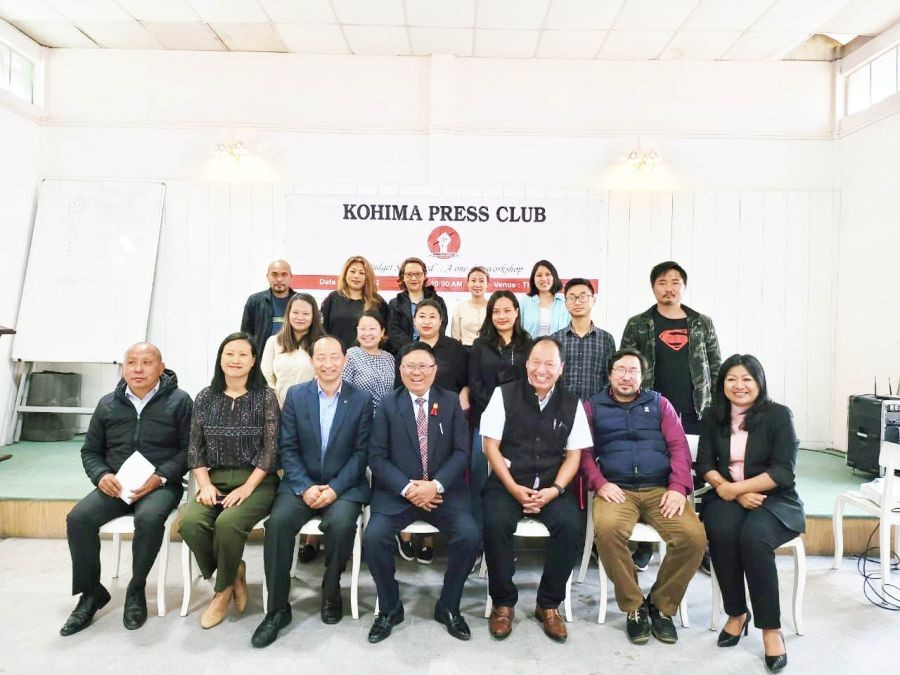Kohima Press Club members with the resource persons during the ‘Budget Simplified’ workshop in Kohima on March 12. (Morung Photo)

Kohima journos attend workshop on state budget
Morung Express News
Kohima | March 12
Besides having the highest number of government employees, the state of Nagaland has the highest number of government departments and establishments totalling to 70 followed by neighbouring state Assam with 50.
This was revealed during the one-day ‘Budget Simplified’ workshop organised by the Kohima Press Club on March 12 at The Heritage (old DC Bungalow) conference hall. With the upcoming Budget Session, the workshop was organised in order to equip journalists with a better understanding of the state’s finances and budget while reporting.
The resource persons were Ketoulhou Metha, Senior Research Officer (Budget) and Y Kikheto Sema, Agriculture Production Commissioner (APC) and former Secretary Finance who presented the status and overview of the state finances and ways forward.
Over employment a major issue
Both the resource persons concurred that ‘over employment’ in the government sector is a major issue in the state as major chunk of the state’s finances are spent on salaries and wages amounting to Rs 5303.20 cr and Rs 1752.48 cr on pension.
According to the APC, as of March 31, 2020, Nagaland has a total of 1,00,001 regular employees, 24,854 fixed employees and 14,744 work-charge employees totalling the number of government employees to 1,40,765.
He also observed that the state is spending huge on education outside the state, dependence on other states for essential commodities particularly meat and meat products, fruits and vegetables amounting to Rs 1500 cr annually.
Another issue, Sema pointed out is the ‘indecent amount of money spent during elections, poor work culture and dependence on others.’
Sources of income and expenditures
The main sources of funds for the state, Metha informed is from share of Central Taxes, Revenue Deficit Grant; State’s Own Tax -SGST, VAT, road tax etc; non-tax revenue -power, NST, lotteries, water supply, forest royalty etc; Centrally Sponsored Schemes/NEC/NLCPR; Externally Aided Projects (EAP); security related expenditure reimbursements; other Finance Commission Awards and borrowings from Open Market Loan, General Provident Fund, Negotiated Loan–HUDCO/NABARD/REC etc, Loan component for EAPs and WMA from RBI (short Term).
Major items of expenditure are on salaries and wages, pensions, debt servicing, administrative/establishment charges, grants to PSUs, asset maintenance, power purchase, Centrally Sponsored Schemes/NEC/NLCPR, EAPs, state development (earlier State Plan), state programmes and state share for CSS.
Briefly, they also explained the various components under finances and budget, and responded to the queries of the journalists.
Way forward with austerity measures
With a need to reduce revenue expenditure of the state, Metha in his way forward, suggested rationalising of government employment and also creating an alternate congenial environment for economic growth.
While proposing that the state should facilitate private sectors to grow to accommodate the upcoming population, he observed the need to increase capital investment and look more towards EAP funding for capital projects. He also emphasised on the huge potential in tourism sector.
Meanwhile, citing the unresolved Naga political issue as a major setback, Sema suggested on early solution to Naga Political issue and investment on quality educational institutions in the state.
Besides more investment on infrastructure viz. road, power, water, and agri & allied sectors, he also recommended on reforms of election process and clean elections, and inclusion of bio-diversity, ‘culture of work and eat,’ etc., in the syllabus of elementary education, Sunday school, pulpit preaching and teaching.






